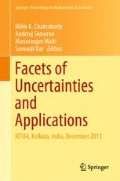Abstract
Since one major disadvantage of application of fuzzy formal concept analysis is that large numbers of fuzzy concepts are generated from fuzzy context, it is practically impossible to analyze such a large amount of concepts. Often it may be required to consider some particular concepts. For example, one might be interested to find out the fuzzy concepts containing all those objects which share some specific property with a specific/required degree from a given fuzzy context. Given such a situation, proto-fuzzy concepts may play a very useful role. This paper proposes a proto-fuzzy concept generation technique using fuzzy graph on uncertainty data. In this paper, we begin with defining a fuzzy graph corresponding to the L-context (fuzzy context). We then go on to demonstrate that t-concepts can be found to correspond with each maximal cliques of t-level graph of the defined fuzzy graph. After that, we determine all those cliques which corresponds to the proto-fuzzy concepts of degree \(t\). Finally, a demonstration has been made using an example with the proposed technique.
Access this chapter
Tax calculation will be finalised at checkout
Purchases are for personal use only
References
Bělohlávek, R.: Lattices generated by binary fuzzy relations (extended abstract). In: Abstract of the 4th International Conference on Fuzzy Sets Theory and Its Applications, Liptovsky Jan’, Slovakia, p. 11 (1998)
Bělohlávek, R.: Fuzzy Relational Systems: Foundations and Principles. Kluwer Academic/Plenum Publishers, New York (2002)
Bělohlávek, R., Sklenar, V., Zacpal, J.: Crisply generated fuzzy concepts. In: Ganter, B., Godin, R. (eds.) ICFCA 2005. Lecturer Notes in Computer Science, vol. 3403, pp. 268–283. Springer, Berlin (2005)
Bělohlávek, R., Vychodil, V.: Reducing the size of fuzzy concept lattices by hedges. In: The IEEE International Conference on Fuzzy Systems, FUZZ-IEEE 2005 (Proceedings on CD), pp. 663–668, Reno, Nevada, USA, 22–25 May 2005, Abstract in Printed Proceedings, p. 44, ISBN: 0-7803-9158-6
Berry, A., Sigayret, A.: Representation a concept lattice by a graph. Discret. Appl. Math. 144, 27–42 (2004)
Bhattacharya, P.: Some remarks on fuzzy graphs. Pattern Recognit. Lett. 6, 297–302 (1987)
Bomze, I.M., Budinich, M., Pardalos, P.M., Pelillo, M.: The maximum clique problem. In: Du, D.-Z., Pardalos, P.M. (eds.) Handbook of Combinatorial Optimization, Supplement vol. A, pp. 1–74. Kluwer, Dordrecht (1999)
Bron, C., Kerbosch, J.: Algorithm 457, finding all cliques of an undirected graph. Commun. ACM 16, 575–577 (1973)
Burusco, A., Fuentes-Gonzalez, R.: The study of the L-fuzzy concept lattices. Mathw. Soft Comput. 3, 209–218 (1994)
Burusco, A., Fuentes-Gonzalez, R.: Construction of the L-fuzzy concept lattice. Fuzzy Sets Syst. 97, 109–114 (1998)
Chakroborthy, M.K., Das, M.: Study in fuzzy relations over fuzzy subsets. Fuzzy Sets Syst. 9, 79–89 (1983)
Chakroborthy, M.K., Das, M.: Fuzzy hypergraphs. In: Proceedings of International Conference on Logic Programming Born (1997)
Chiba, N., Nishizeki, T.: Arboricity and subgraph listing algorithms. SIAM J. Comput. 14, 210–223 (1985)
Dubois, D., Prade, H.: Fuzzy Sets and Systems, Theory and Applications. Academic Press, New York (1980)
Ganter, B.: Two Basic Algorithms in Concept Analysis, Preprint 831. Technische Hochschule Darmstadt, Darmstadt (1984)
Ganter, B., Wille, R.: Formal Concept Analysis, Mathematical Foundation. Springer, Berlin (1999)
Ghosh, P., Kundu, K., Sarkar, D.: Fuzzy graph representation of a fuzzy concept lattice. Fuzzy Sets Syst. 161, 1669–1675 (2010)
Goguen, J.A.: L-fuzzy set. J. Math. Anal. Appl. 18(1), 145–174 (1967)
HöHle, U.: On the fundamentals of fuzzy set theory. J. Math Anal. Appl. 201, 786–826 (1996)
Jhonson, D.S., Yannakakis, M., Papadimitriou, C.H.: On generating all maximal independent sets. Inf. Process. Lett. 27, 119–123 (1988)
John, N.M., Premchand, S.N.: Fuzzy Graphs Fuzzy Hyper Graph. Springer, Berlin (2000)
Kaufmann, A.: Introduction a lathèorielath des sous-ensembles flous. Masson, Paris (1973)
Koch, I.: Enumerating all connected maximal common subgraphs in two graphs. Theor. Comput. Sci. 250, 1–30 (2001)
Krajči, S.: Cluster based efficient generation of fuzzy concepts. Neural Netw. World 5, 521–530 (2003)
Krídlo, O., Krajči, S., Proto-fuzzy concepts, their retrieval and usage. In: Proceedings of Sixth International Conference on Concept Lattices and their Applications (CLA 2008), pp. 83–96
Krídlo, O., Krajči, S., Fuzzy concept lattice is made by proto-fuzzy concepts. IFSA-EUSFLAT (2009)
Pollandt, S.: Fuzzy Begriffe. Springer, Berlin (1997)
Rosenfield, A.: Fuzzy graphs. In: Zadeh, L.A., Fu, K.-S., Tanaka, K., Shimura, M. (eds.) Fuzzy Sets and their Applications to Cognitive and Decision Process, pp. 77–96. Academic Press, New York (1975)
Takeda, E.: Connectvity in fuzzy graphs. Tech. Rep. Osaka Univ. 23, 343–352 (1973)
Tomitaa, E., Tanakaa, A., Takahashia, H.: The worst-case time complexity for generating all maximal cliques and computational experiments. Theor. Comput. Sci. 363, 28–42 (2006)
Wille, R.: Restructuring lattice theory: an approach based on hierarchies of concepts. In: Rival, I. (ed.) Ordered Sets, pp. 445–470. Reidel, Dordrecht, Boston (1982)
Yeh, R.T., Bang, S.Y.: Fuzzy relations, fuzzy graphs, and their applications to clustering analysis. In: Zadeh, L.A., Fu, K.S., Shimura, M. (eds.) Fuzzy Sets and their Applications, pp. 125–149. Academic Press, New York (1975)
Zadeh, L.A.: Fuzzy sets. Inf. Control 8, 338–353 (1965)
Zaman, W., Ghosh, P., Dutta, K.K., Basu, P.N.: A framework to incorporate domain knowledge modeling. Math. Sci. Int. Res. J. 2, 474–478 (2013)
Zaman, W., Ghosh, P., Basu, P. N.: A Prototype to incorporate domain knowledge computation in an education system. Br. J. Educ. Technol. (communicated)
Author information
Authors and Affiliations
Corresponding author
Editor information
Editors and Affiliations
Rights and permissions
Copyright information
© 2015 Springer India
About this paper
Cite this paper
Ghosh, P., Kundu, K. (2015). Proto-Fuzzy Concepts Generation Technique Using Fuzzy Graph. In: Chakraborty, M.K., Skowron, A., Maiti, M., Kar, S. (eds) Facets of Uncertainties and Applications. Springer Proceedings in Mathematics & Statistics, vol 125. Springer, New Delhi. https://doi.org/10.1007/978-81-322-2301-6_5
Download citation
DOI: https://doi.org/10.1007/978-81-322-2301-6_5
Publisher Name: Springer, New Delhi
Print ISBN: 978-81-322-2300-9
Online ISBN: 978-81-322-2301-6
eBook Packages: Mathematics and StatisticsMathematics and Statistics (R0)

